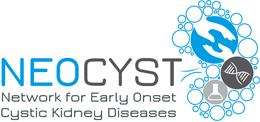The NEOCYST project 5 is dedicated to translational research on cell biological questions. Within this project biosamples of genotyped and deeply phenotyped patients will be used to study molecular mechanism that are relevant for progression of cystic kidney diseases and that may explain the partial phenotypical overlap between different entities of cystic kidney diseases.
Cell programming and signaling cascades
University of Cologne
The project in Cologne pays special attention to ARPKD and nephronophthisis, the most common genetic cause of end stage renal disease in childhood and adolescence. Using state-of-the-art techniques of cell (re)programming and genomic engineering we aim for novel insights into dysregulated signaling cascades in cystic kidney disease and hope to fill up lacunae in the understanding of the cellular pathogenesis of cystic kidney diseases. Ultimately,this might contribute to the identification of potential novel therapeutic approaches.
Within the first funding period (2016-2019) we were able to identify mRNA and protein expression signatures in cystic kidney diseases. We also identified new genes responsible for the development of ciliopathies. We furthermore characterized changes of the ciliary lengths in patients suffering from ciliopathies. Methodical principles that enable us to characterize the epithelial function in urine cells from patients have been established.
We are now (second funding period 2019-2022) focusing on cell biological and molecular effects of individual patient mutations on changes within cilia associated signal transport cascades, development of epithelial cell polarity and epithelial function. We then aim to compare these effects with results from pharmacological screens to ultimately establish new mutation specific therapies for patients suffering from cystic kidney disease.
Cell adhesion and epithelial morphogenesis
Hannover Medical School
In Hannover, the project focuses on altered epithelial cell characteristics that lead to defective homeostasis of tubular and collecting duct epithelia and that cause or deteriorate renal cyst formation. Altered cell properties are being studied ex vivo using urine-derived renal epithelial cells (UREC) and correlated to quantitative parameters of cell adhesion and epithelial morphogenesis. The study uses ARPKD as a model to determine relevant parameters, and subsequently, will include all cystic kidney diseases studied by the NEOCYST consortium. Assessment of quantitative cell characteristics based on state-of-the-art cell biological tools is expected to reveal disease-specific alterations of cell function. Correction of epithelial cell defects will be addressed in ex vivo analyses of UREC from patients and may ultimately allow identification of potential novel therapeutic approaches for entities of cystic kidney disease and for individualized treatment.
Ciliary structure and function
Medical University of Münster
Our main goal within this subproject is the analysis of the ciliary structure in patients suffering from cystic kidney disease. In detail we aim to characterize the ciliary lengths, quantity, axonemal structure and protein formation. We will cultivate and analyze cells obtained from patient´s urine samples and nasal biopsies. Obtained results will then be correlated with clinical data. We target to analyze a minimum of three genetically identified patients from each of the following disease groups: NPHP, BBS, PKHD1 for ARPKD and HNF1ß. Ciliary structures will be analyzed using immunofluorescent and electron microscopy techniques. We ultimately hope to be able to gain a better understanding of ciliopathy pathogeneses and thereby lead the way to the development of new therapeutic options and the identification of new ciliary markers that could potentially be used in therapy control.
Within the first funding period (2016-2019) we were able to establish the methodical principles of extracting and culturing human respiratory cells and fibroblasts. More than 150 patient nasal biopsies have been collected, cultivated and partially analyzed. Furthermore we were able to show that the ciliary beat pattern of patients suffering from cystic kidney disease is defective. As a result we included the characterization of primary and secondary respiratory epithelial cells into this project.
We will use the second funding period (2019-2022) to finalize the analysis of ciliary structures from the derived patient material, especially under the aspect of statistic relevance and genotype/phenotype correlations. Furthermore we aim to investigate the basal body orientation in order to clarify the planar cell polarity status in patients with ciliopathies.
